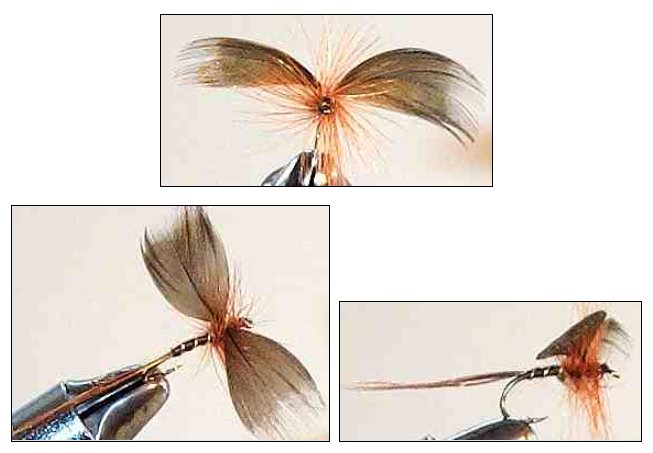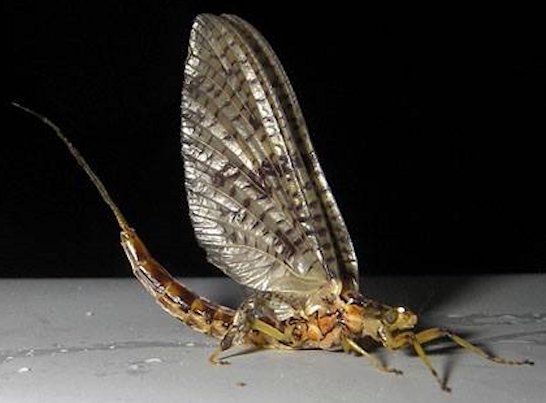Brown Drake Mayfly Spinner
Brown Drakes belong to the Ephemeridae species of mayflies. After breaking through the surface film and their nymphal shucks these large duns struggle frantically to get off the water. This makes them very conspicuous and easy prey for both birds and trout.

FANWING MAYFLY SPINNER DRY FLY PATTERNS. Hook size 12 16 - $US each
Brown Drake Mayflies float for long distances waiting for their wings to fill with blood. When the wings are fully inflated and dry these duns flutter furiously as they try to lift their large bodies into the air. This fluttering action often is the trigger for some violent strikes They have all a deserved reputation for producing great hatches that can entice large lurker trout to leave their lays and feed greedily on the hatching Drakes. When they do hatch their emergence is not a subtle event.

The Brown Drake nymph is normally not eaten by trout or grayling searching through the debris and vegetation on the river or lake bottom. They would if they could find them but that is the problem. This mayfly’s nymph is a burrowing species. They only become of interest to the fly fisherman an hour before a hatch, during the emergence and an hour afterwards when the Brown Drake nymph can still be found in the water. The fish will take the nymphs as they swim to the surface as well as taking the duns floating in the surface film. Not all nymphs make it to the surface and they are left drifting in the water currents. Consider using a team of three flies. A Brown Drake dry fly on the surface with Brown Gold Ribbed Hares Ear Nymphs or a Greenwell’s Glory soft hackle wet fly on droppers searching the depths below for nymph feeding trout.
Most hatches of Brown Drake mayfly duns emerge in slow to moderate currents that normally flow over gravel or fine sand bottoms. In most areas the hatches start at dusk. This is a large mayfly and should be matched with large hook. Look for a feeding trout causing ripples on the water surface. Try and count the seconds between the rises. If you find a 10 second count passes before the fish returns to the surface again then begin false casting at the count of nine and lay your Brown Drake dry fly just upstream far enough so it dead drifts over the last position you saw the trout feeding, on the count of 10. To have success fly fishing dusk and night feeding trout you need to find a location where there are predictable feeding fish.
You then need to be able to accurately and delicately place a fly in the right spot with an accurate imitation of the hatching dun mayflies. Do not wait until dusk to start practicing this skill. So as not to waste the time you spend on the water you must practice and practice. If you do not live near water go to a park or open space and set out targets on the ground at different distances from you. Practice hitting them softly. Yes you will get strange looks from the dog walkers and mothers pushing their prams but who cares! After dark trout fishing is very tricky but once you land a good sized trout most fisherman get hooked themselves on this challenging aspect of this sport.
FACEBOOK READER'S COMMENTS
June on the Au Sable river is all about dry fly fishing for big brown trout! This month gets all the big mayflies and for the biggest trout its typically done in the dark! March Browns are going now. Next up is Browns Drakes and Isonychia. Then comes the best of year - the Hex Hatch! - Derek Michelin
FACEBOOK COMMENT
Brown Drakes hatch starting mid to late June on the Au Sable. Peak times for big browns. June is the time for dark flies in the dark. - Kelly Neuman


Fly Fishing books

